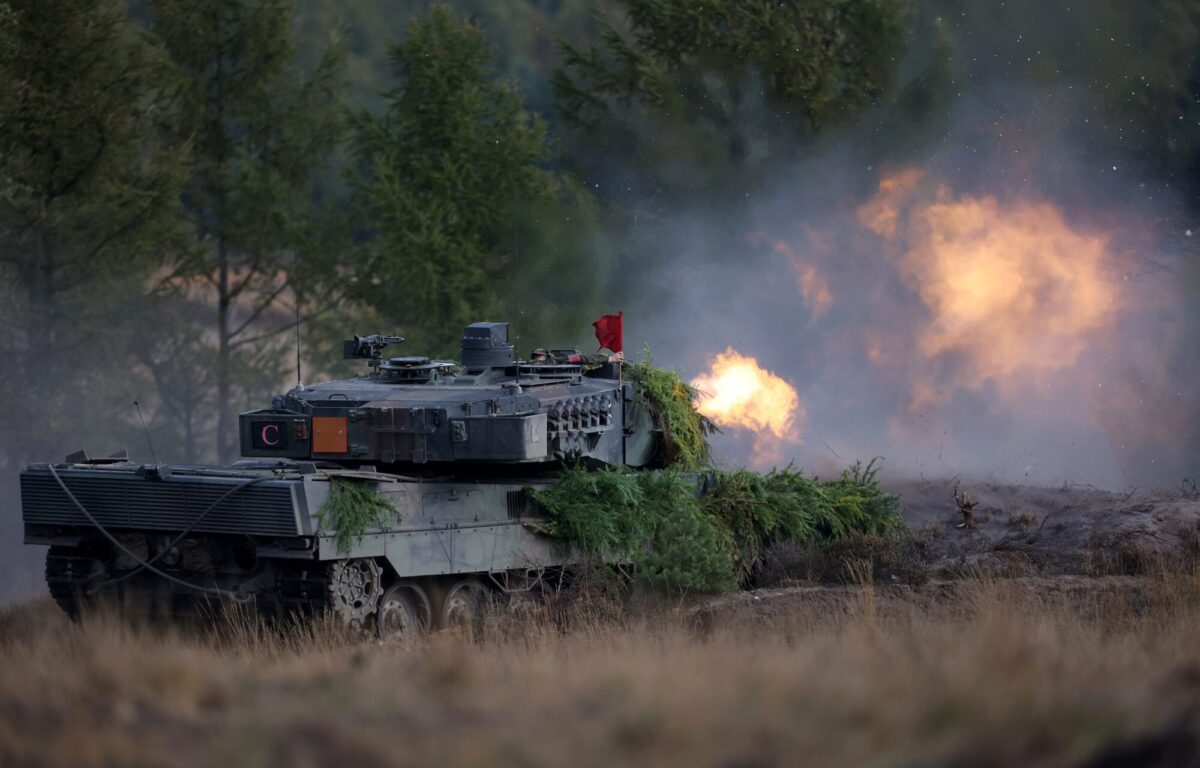
A Leopard 2 main battle tank of the German armed forces Bundeswehr shoots during a visit by the German Chancellor of the troops during a training exercise at the military ground in Ostenholz, northern Germany, on October 17, 2022. Germany on January 25, 2023 approved the delivery of Leopard 2 tanks to Ukraine, after weeks of pressure from Kyiv and many allies. Berlin will provide a company of 14 Leopard 2 A6 tanks from the Bundeswehr stocks and is also granting approval for other European countries to send tanks from their own stocks to Ukraine, a government spokesman said in a statement. (Photo by Ronny Hartmann / AFP)
Germany has crossed the Rubicon—or so it seems. On Wednesday, January 25th, Chancellor Olaf Scholz confirmed on the floor of the Bundestag that 14 of Germany’s Leopard 2 tanks will see battle in the Russo-Ukrainian war.
To the sound of applause from even his most vociferous critics, Scholz said that “Germany will always be at the forefront when it comes to supporting Ukraine.”
While, for now, Berlin limits its assistance to one company (14 tanks) from its own stockpile, eventually the German government wants to assemble two battalions (80 tanks in total) together with other NATO countries.
In addition to coordinating this effort, Germany also pledges to provide training on its own soil, as well as logistics, maintenance, and ammunition. Scholz said the country will also start issuing transfer permits to partner countries that want to deliver Leopard 2’s from their stocks.
While Germany must do everything possible, “at the same time we must prevent the war from escalating into a war between Russia and NATO,” Scholz was careful to add, soothing fears of open conflict among the citizenry. Asking for their trust, he emphasized that Germany would never send in its own troops or aircraft.
According to German Defence Minister Boris Pistorius, who welcomed the “historic” decision, Germany will be able to deliver its tanks to Ukraine in three to four months. He stressed, however, that this was no cause for “shouts of hallelujah.”
Ukrainian Prime Minister Volodymyr Zelensky thanked Scholz for Berlin’s “important and timely decisions,” saying they were a “green light for partners to supply similar weapons.”
German main battle tanks, further broadening of defense support & training missions, green light for partners to supply similar weapons. Just heard about these important & timely decisions in a call with @OlafScholz. Sincerely grateful to the Chancellor and all our friends in 🇩🇪.
— Володимир Зеленський (@ZelenskyyUa) January 25, 2023
Predictably, the Russian embassy in Berlin did not take well to the news. The embassy accused Germany of making an “extremely dangerous decision” as it ditched its “historical responsibility to Russia,” referring to the Nazi regime’s invasion of Russia during WWII.
The embassy said the tank deliveries would escalate the conflict to a new level, making it de facto “permanent.” President Vladimir Putin made no specific comment on the news.
Moscow has repeatedly stated that the fielding of foreign tanks on the Ukrainian battlefield would only serve to prolong the suffering of the Ukrainians.
So far, Finland and Norway have announced they would send Leopards, as has Poland, which had already, pro forma, asked for Berlin’s approval.
The matter is still being discussed in Spain and the Netherlands, and France is considering sending its Leclercs. Earlier in January, Britain, the first to send heavy tanks, offered a company of 14 of its Challengers.
Germany’s decision, as reported by The European Conservative, came on the heels of earlier rumors that the country was close to stepping up its support for the Ukrainian war effort.
Faced with unrelenting pressure both home and abroad to deliver the Leopards and grant export licenses to other countries who have them, Scholz has seemingly caved.
Yet, Chancellor Scholz’ hesitation might have served a purpose. Not wanting to be left holding the bag should things turn sour, Scholz got the U.S. on board first—no Leopards without Abrams.
The White House has long voiced opposition to sending its M1 Abrams, citing impracticalities such as their heavy fuel consumption and the high level of maintenance they require.
On Wednesday, January 25th, U.S. President Joe Biden announced that Washington will send 31 of its vaunted Abrams tanks after all.
Biden said this would “enhance Ukraine’s capacity to defend its territory and achieve its strategic objectives” because they are “the most capable tanks in the world.” At the same time, he stressed it was a defensive measure as it helped protect Ukrainian land, and that it was “not an offensive threat to Russia.”
President Zelensky thanked Biden for his “powerful decision,” reminding all that “today the free world is united as never before for a common goal— liberation of Ukraine. We’re moving forward.”
Thank you @POTUS for another powerful decision to provide Abrams to 🇺🇦. Grateful to 🇺🇸 people for leadership support! It's an important step on the path to victory. Today the free world is united as never before for a common goal – liberation of 🇺🇦. We're moving forward
— Володимир Зеленський (@ZelenskyyUa) January 25, 2023
As it provides a training program to maintain and operate the tanks to address the maintenance issues often experienced with the M1 Abram, the U.S. will also send eight M88 recovery vehicles to go along with them.
These, a senior administration official said during a background press call in anticipation of Biden’s speech, will “provide recovery operations to make sure that the Ukrainians will be able to keep these Abrams up and running.”
The Abrams’ delivery to Ukraine might however “take time,” according to Biden, since the U.S. first needs to ensure “Ukrainians are fully prepared to integrate the Abram tanks into their defenses.”
